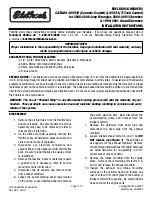
5. Raise the vehicle by turning the jack screw clock-
wise. Raise the vehicle only until the tire just clears
the surface and enough clearance is obtained to
install the spare tire. Minimum tire lift provides
maximum stability.
WARNING!
Raising the vehicle higher than necessary can make
the vehicle less stable. It could slip off the jack and
hurt someone near it. Raise the vehicle only enough
to change the tire.
6. Remove the lug nuts and wheel.
7. Mount the spare tire on the axle.
8. Install the lug nuts with the cone-shaped end toward
the wheel. Lightly tighten the lug nuts clockwise.
WARNING!
To avoid the risk of forcing the vehicle off the jack, do
not tighten the wheel nuts fully until the vehicle has
been lowered. Failure to follow this warning may
result in serious injury.
9. Lower the vehicle by turning the jack screw to the
counterclockwise, and remove the jack.
10. Finish tightening the wheel bolts. Push down on
the wrench while at the end of the handle for
increased leverage. Tighten the wheel bolts in a
star pattern until each wheel bolt has been tight-
ened twice
page 342. If in doubt about the
correct tightness, have them checked with a torque
wrench by an authorized dealer or at a service
station.
11. After 25 miles (40 km), check the lug nut torque
with a torque wrench to ensure that all lug nuts are
properly seated against the wheel.
12. Remove the jack assembly and wheel blocks.
13. Secure the jack and tools in their proper locations.
14. Secure the damaged wheel/tire on the spare tire
carrier. Torque down lug nuts and locking lug nut.
15. Return the lock bolt to the lock position on the
camera cover by turning the lock clockwise using
the provided #40 torx head driver and ratchet.
Then, reinstall the camera cover by slipping it over
the camera/tire carrier until it snaps into place.
WARNING!
A loose tire or jack thrown forward in a collision or
hard stop, could endanger the occupants of the
vehicle. Always stow the jack parts and the spare tire
in the places provided.
JUMP STARTING
If your vehicle has a discharged battery, it can be jump
started using a set of jumper cables and a battery in
another vehicle, or by using a portable battery booster
pack. Jump starting can be dangerous if done improp-
erly, so please follow the procedures in this section
carefully.
The vehicle requires its 12 Volt battery power to turn-on
the vehicle's high voltage battery. The high voltage bat-
tery is used to charge the 12 Volt battery, provide elec-
tric vehicle operation, and to start the vehicle's gas
engine. If the 12 Volt battery has been discharged, the
Rear Jacking Location
Lock Bolt Location
274
IN CASE OF EMERGENCY
5538906_24_JL_OM_EN_USC_t_E1.pdf 274
5/22/2023 9:02:29 AM
















































